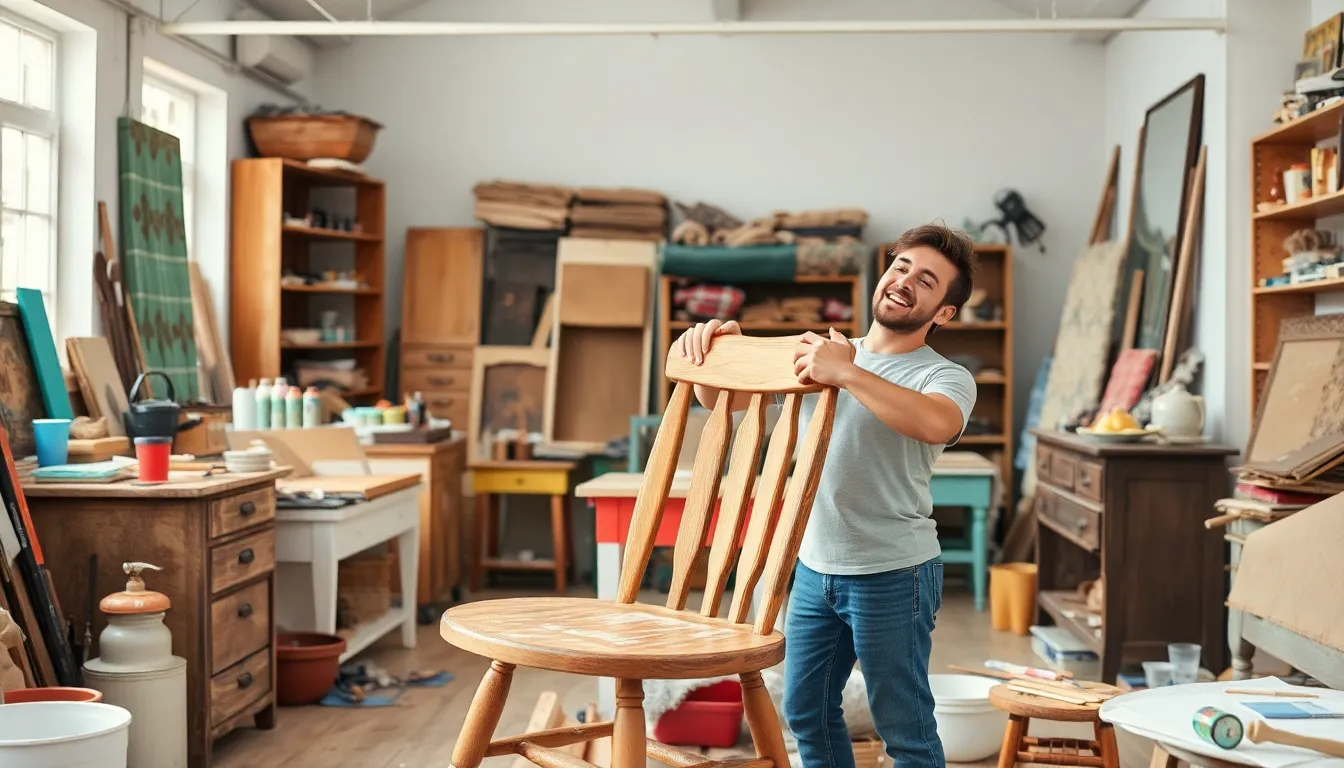In a world where trends come and go faster than a cat can knock a glass off a table, repurposing furniture has become the ultimate DIY superhero. Why toss that old dresser when it could transform into a chic TV stand or a trendy bench? With a little creativity and elbow grease, anyone can turn their cluttered corners into stylish statements that even Marie Kondo would applaud.
Table of Contents
ToggleWhat Is Repurposing Furniture?
Repurposing furniture involves taking old or unwanted pieces and transforming them into new, functional items. This method emphasizes creativity in design, allowing individuals to personalize spaces without significant financial investment. Many people view repurposing as a way to reduce waste, contributing to sustainability in home decor.
Old dressers can become stylish TV stands, while chairs may turn into unique garden planters. Individuals often consider their existing inventory of furniture to discover hidden potential. They can personalize items through painting, refinishing, or restructuring, aiding in the development of distinctive home aesthetics.
Transforming furniture not only breathes new life into neglected pieces but also supports an eco-friendly lifestyle. In addition to providing practical benefits, this practice encourages craftsmanship and self-expression. The process of repurposing often leads to the discovery of new skills, fostering confidence in DIY abilities.
Various resources and communities support those interested in repurposing projects. Online platforms offer tutorials, while local workshops may provide hands-on guidance. Individuals can rapidly find inspiration from social media, showcasing creative ideas that spark their imagination.
Ultimately, repurposing furniture serves as a fulfilling endeavor, blending creativity with ecological responsibility. By embracing this trend, people can cultivate beautiful, functional spaces that reflect their unique tastes.
Benefits of Repurposing Furniture

Repurposing furniture presents numerous advantages that enhance both personal space and environmental health.
Environmental Impact
Repurposing furniture significantly reduces landfill waste. Millions of tons of furniture end up discarded each year, contributing to pollution and resource depletion. Transforming old items into new creations minimizes the need for new materials, promoting sustainability. Repurposed furniture often requires fewer resources for renovation compared to new items. This practice conserves energy and lowers carbon footprints. Additionally, it fosters a culture of reuse, encouraging communities to value creativity over consumption. By choosing to repurpose instead of discard, individuals contribute to a cleaner environment while embracing innovative design.
Cost Savings
Repurposing furniture leads to substantial cost savings. New furniture can cost hundreds or thousands of dollars; however, repurposing often requires minimal investment. Many projects can utilize paint, hardware, or fabric, resulting in fashion without breaking the bank. Personalizing items allows individuals to create distinctive styles tailored to their taste. Local thrift stores and garage sales often offer low-cost or free items ripe for transformation. Savings extend beyond money, as one’s creativity flourishes through exploring DIY possibilities. Ultimately, repurposing furniture generates both financial benefits and unique home decor.
Popular Techniques for Repurposing
Repurposing furniture involves several effective techniques that elevate the style and functionality of older pieces. Common methods include upcycling and painting or refinishing.
Upcycling
Upcycling takes unwanted furniture and transforms it into something new and exciting. This method often includes creative alterations like adding new hardware or reconfiguring shapes. For example, an old dresser could become a chic storage bench. By incorporating different materials or styles, individuals can reflect their personal tastes while creating unique home decor items. It’s a way to repurpose items into functional art without significant financial investment.
Painting and Refinishing
Painting and refinishing breathe new life into furniture with color and texture. Individuals often choose bright shades or trendy finishes to modernize outdated pieces. For instance, a plain wooden table can turn into a vibrant centerpiece with a fresh coat of paint. Refinishing involves sanding and coating surfaces, bringing restored charm to worn-out items. This technique allows for customization, making pieces look contemporary while preserving their original character.
Tips for Successful Repurposing
Repurposing furniture can be an enjoyable and rewarding experience. Following a few key tips ensures a successful transformation.
Choosing the Right Furniture
Selecting the right piece of furniture sets the foundation for any project. Look for items with solid structure, such as dressers or bookshelves. Consider pieces that offer flexibility, allowing various design possibilities. Avoid furniture with extensive damage that requires significant repair. Identify outdated styles that can be modernized with minimal alterations. Explore thrift stores or garage sales to uncover hidden gems. Think creatively about how a piece could serve a new purpose in your home.
Tools and Materials Needed
Gathering essential tools and materials simplifies the repurposing process. A power drill, screws, and a screwdriver will facilitate assembly and disassembly. Sandpaper and paintbrushes prepare surfaces for refinishing. Select paint or wood stain to match your desired aesthetic. Consider using adhesive to attach different components securely. Including sealants ensures durability, especially for frequently used items. Measuring tape guarantees precision when altering sizes or proportions. Organizing tools and materials beforehand streamlines the project and enhances productivity.
Repurposing furniture is more than just a trend; it’s a movement towards sustainability and creativity. By breathing new life into old pieces, individuals not only create unique home decor but also contribute to environmental conservation. The process encourages a deeper connection with one’s living space and fosters a sense of accomplishment.
With countless techniques available, anyone can embark on this rewarding journey. Embracing the art of repurposing allows for personal expression while saving money and reducing waste. As people continue to discover the potential hidden in their furniture, they cultivate stylish and functional environments that truly reflect their personality.



